#Scraping data from food delivery platforms
Explore tagged Tumblr posts
Text
Read this blog to know why to scrape restaurant & grocery food allergy data to collect information regarding restaurants, food, menus, type of allergy encountered, etc.
#Scrape Restaurant & Grocery Food Allergy Data#Restaurant food data scraping#Scrape restaurant menus#Scrape food prices from different restaurants#Scraping data from food delivery platforms#scraping food allergy data#scraping food and grocery review data
0 notes
Text

Lensnure Solution provides top-notch Food delivery and Restaurant data scraping services to avail benefits of extracted food data from various Restaurant listings and Food delivery platforms such as Zomato, Uber Eats, Deliveroo, Postmates, Swiggy, delivery.com, Grubhub, Seamless, DoorDash, and much more. We help you extract valuable and large amounts of food data from your target websites using our cutting-edge data scraping techniques.
Our Food delivery data scraping services deliver real-time and dynamic data including Menu items, restaurant names, Pricing, Delivery times, Contact information, Discounts, Offers, and Locations in required file formats like CSV, JSON, XLSX, etc.
Read More: Food Delivery Data Scraping
#data extraction#lensnure solutions#web scraping#web scraping services#food data scraping#food delivery data scraping#extract food ordering data#Extract Restaurant Listings Data
2 notes
·
View notes
Text
Restaurant Menu Scraping Services—Extract Food Menu Data
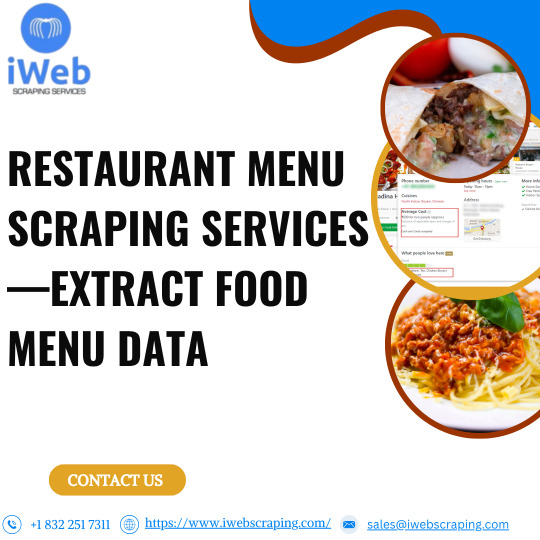
Access detailed restaurant menu data effortlessly with our professional restaurant menu scraping services. Whether you’re building a food delivery app, conducting market research, or managing a restaurant aggregator platform, we help extract structured data directly from restaurant websites. Gather essential information such as dish names, ingredients, pricing, dietary tags, categories, and images — all in a clean, ready-to-use format.
Our automated solutions ensure accurate data collection across thousands of listings, helping you keep menus updated with the latest entries and pricing. From multi-location franchises to local diners, our scraping service supports a wide variety of restaurant platforms. With real-time updates and reliable output formats like CSV, JSON, or Excel, your team can make smarter decisions, faster.
Leverage data to track food trends, analyze competitors, or enhance your digital menu offerings with precision. iWeb scraping ensures secure and efficient extraction — no manual effort needed. Scale your food-related operations confidently with structured, reliable restaurant menu data.
0 notes
Text
Overcoming Bot Detection While Scraping Menu Data from UberEats, DoorDash, and Just Eat
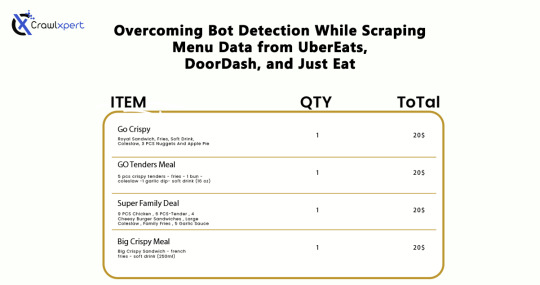
Introduction
In industries where menu data collection is concerned, web scraping would serve very well for us: UberEats, DoorDash, and Just Eat are the some examples. However, websites use very elaborate bot detection methods to stop the automated collection of information. In overcoming these factors, advanced scraping techniques would apply with huge relevance: rotating IPs, headless browsing, CAPTCHA solving, and AI methodology.
This guide will discuss how to bypass bot detection during menu data scraping and all challenges with the best practices for seamless and ethical data extraction.
Understanding Bot Detection on Food Delivery Platforms
1. Common Bot Detection Techniques
Food delivery platforms use various methods to block automated scrapers:
IP Blocking – Detects repeated requests from the same IP and blocks access.
User-Agent Tracking – Identifies and blocks non-human browsing patterns.
CAPTCHA Challenges – Requires solving puzzles to verify human presence.
JavaScript Challenges – Uses scripts to detect bots attempting to load pages without interaction.
Behavioral Analysis – Tracks mouse movements, scrolling, and keystrokes to differentiate bots from humans.
2. Rate Limiting and Request Patterns
Platforms monitor the frequency of requests coming from a specific IP or user session. If a scraper makes too many requests within a short time frame, it triggers rate limiting, causing the scraper to receive 403 Forbidden or 429 Too Many Requests errors.
3. Device Fingerprinting
Many websites use sophisticated techniques to detect unique attributes of a browser and device. This includes screen resolution, installed plugins, and system fonts. If a scraper runs on a known bot signature, it gets flagged.
Techniques to Overcome Bot Detection
1. IP Rotation and Proxy Management
Using a pool of rotating IPs helps avoid detection and blocking.
Use residential proxies instead of data center IPs.
Rotate IPs with each request to simulate different users.
Leverage proxy providers like Bright Data, ScraperAPI, and Smartproxy.
Implement session-based IP switching to maintain persistence.
2. Mimic Human Browsing Behavior
To appear more human-like, scrapers should:
Introduce random time delays between requests.
Use headless browsers like Puppeteer or Playwright to simulate real interactions.
Scroll pages and click elements programmatically to mimic real user behavior.
Randomize mouse movements and keyboard inputs.
Avoid loading pages at robotic speeds; introduce a natural browsing flow.
3. Bypassing CAPTCHA Challenges
Implement automated CAPTCHA-solving services like 2Captcha, Anti-Captcha, or DeathByCaptcha.
Use machine learning models to recognize and solve simple CAPTCHAs.
Avoid triggering CAPTCHAs by limiting request frequency and mimicking human navigation.
Employ AI-based CAPTCHA solvers that use pattern recognition to bypass common challenges.
4. Handling JavaScript-Rendered Content
Use Selenium, Puppeteer, or Playwright to interact with JavaScript-heavy pages.
Extract data directly from network requests instead of parsing the rendered HTML.
Load pages dynamically to prevent detection through static scrapers.
Emulate browser interactions by executing JavaScript code as real users would.
Cache previously scraped data to minimize redundant requests.
5. API-Based Extraction (Where Possible)
Some food delivery platforms offer APIs to access menu data. If available:
Check the official API documentation for pricing and access conditions.
Use API keys responsibly and avoid exceeding rate limits.
Combine API-based and web scraping approaches for optimal efficiency.
6. Using AI for Advanced Scraping
Machine learning models can help scrapers adapt to evolving anti-bot measures by:
Detecting and avoiding honeypots designed to catch bots.
Using natural language processing (NLP) to extract and categorize menu data efficiently.
Predicting changes in website structure to maintain scraper functionality.
Best Practices for Ethical Web Scraping
While overcoming bot detection is necessary, ethical web scraping ensures compliance with legal and industry standards:
Respect Robots.txt – Follow site policies on data access.
Avoid Excessive Requests – Scrape efficiently to prevent server overload.
Use Data Responsibly – Extracted data should be used for legitimate business insights only.
Maintain Transparency – If possible, obtain permission before scraping sensitive data.
Ensure Data Accuracy – Validate extracted data to avoid misleading information.
Challenges and Solutions for Long-Term Scraping Success
1. Managing Dynamic Website Changes
Food delivery platforms frequently update their website structure. Strategies to mitigate this include:
Monitoring website changes with automated UI tests.
Using XPath selectors instead of fixed HTML elements.
Implementing fallback scraping techniques in case of site modifications.
2. Avoiding Account Bans and Detection
If scraping requires logging into an account, prevent bans by:
Using multiple accounts to distribute request loads.
Avoiding excessive logins from the same device or IP.
Randomizing browser fingerprints using tools like Multilogin.
3. Cost Considerations for Large-Scale Scraping
Maintaining an advanced scraping infrastructure can be expensive. Cost optimization strategies include:
Using serverless functions to run scrapers on demand.
Choosing affordable proxy providers that balance performance and cost.
Optimizing scraper efficiency to reduce unnecessary requests.
Future Trends in Web Scraping for Food Delivery Data
As web scraping evolves, new advancements are shaping how businesses collect menu data:
AI-Powered Scrapers – Machine learning models will adapt more efficiently to website changes.
Increased Use of APIs – Companies will increasingly rely on API access instead of web scraping.
Stronger Anti-Scraping Technologies – Platforms will develop more advanced security measures.
Ethical Scraping Frameworks – Legal guidelines and compliance measures will become more standardized.
Conclusion
Uber Eats, DoorDash, and Just Eat represent great challenges for menu data scraping, mainly due to their advanced bot detection systems. Nevertheless, if IP rotation, headless browsing, solutions to CAPTCHA, and JavaScript execution methodologies, augmented with AI tools, are applied, businesses can easily scrape valuable data without incurring the wrath of anti-scraping measures.
If you are an automated and reliable web scraper, CrawlXpert is the solution for you, which specializes in tools and services to extract menu data with efficiency while staying legally and ethically compliant. The right techniques, along with updates on recent trends in web scrapping, will keep the food delivery data collection effort successful long into the foreseeable future.
Know More : https://www.crawlxpert.com/blog/scraping-menu-data-from-ubereats-doordash-and-just-eat
#ScrapingMenuDatafromUberEats#ScrapingMenuDatafromDoorDash#ScrapingMenuDatafromJustEat#ScrapingforFoodDeliveryData
0 notes
Text
Singapore Restaurant Insights via Food App Dataset Analysis
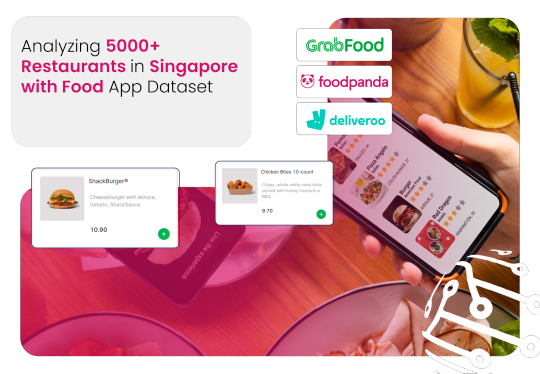
Introduction
ArcTechnolabs provided a comprehensive Food Delivery Menu Dataset that helped the client extract detailed menu and pricing data from major food delivery platforms such as GrabFood, Foodpanda, and Deliveroo. This dataset included valuable insights into restaurant menus, pricing strategies, delivery fees, and popular dishes across different cuisine types in Singapore. The data also covered key factors like restaurant ratings and promotions, allowing the client to benchmark prices, identify trends, and create actionable insights for strategic decision-making. By extracting menu and pricing data at scale, ArcTechnolabs empowered the client to deliver high-impact market intelligence to the F&B industry.
Client Overview
A Singapore-based market intelligence firm partnered with ArcTechnolabs to analyze over 5,000 restaurants across the island. Their goal was to extract strategic insights from top food delivery platforms like GrabFood, Foodpanda, and Deliveroo—focusing on menu pricing, cuisine trends, delivery coverage, and customer ratings. They planned to use the insights to support restaurant chains, investors, and FMCG brands targeting the $1B+ Singapore online food delivery market.
The Challenge
The client encountered several data-related challenges, including fragmented listings across platforms, where the same restaurant had different menus and prices. There was no unified data source available to benchmark cuisine pricing or delivery charges. Additionally, inconsistent tagging for cuisines, promotions, and outlets created difficulties in standardization. The client also faced challenges in extracting food item pricing at scale and needed to perform detailed analysis by location, cuisine type, and restaurant rating. These obstacles highlighted the need for a structured and reliable dataset to overcome the fragmentation and enable accurate insights.They turned to ArcTechnolabs for a structured, ready-to-analyze dataset covering Singapore’s entire food delivery landscape.
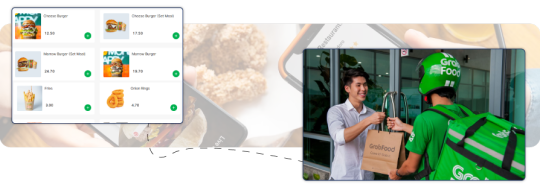
ArcTechnolabs Solution:
ArcTechnolabs built a custom dataset using data scraped from:
GrabFood Singapore
Foodpanda Singapore
Deliveroo SG
The dataset captured details for 5,000+ restaurants, normalized for comparison and analytics.
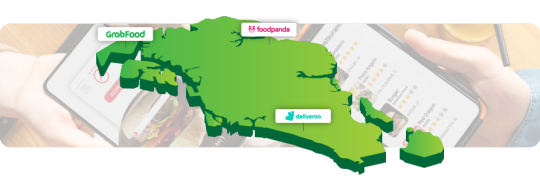
Sample Dataset Extract

Client Testimonial
"ArcTechnolabs delivered exactly what we needed—structured, granular, and high-quality restaurant data across Singapore’s top food delivery apps. Their ability to normalize cuisine categories, menu pricing, and delivery metrics helped us drastically cut down report turnaround time. With their support, we expanded our client base and began offering zonal insights and cuisine benchmarks no one else in the market had. The quality, speed, and support were outstanding. We now rely on their weekly datasets to power everything from investor reports to competitive pricing models."
— Director of Research & Analytics, Singapore Market Intelligence Firm
Conclusion
ArcTechnolabs enabled a market intelligence firm to transform fragmented food delivery data into structured insights—analyzing over 5,000 restaurants across Singapore. With access to a high-quality, ready-to-analyze dataset, the client unlocked new revenue streams, faster reports, and higher customer value through data-driven F&B decision-making.
Source >> https://www.arctechnolabs.com/singapore-food-app-dataset-restaurant-analysis.php
#FoodDeliveryMenuDatasets#ExtractingMenuAndPricingData#FoodDeliveryDataScraping#SingaporeFoodDeliveryDataset#ScrapeFoodAppDataSingapore#ExtractSingaporeRestaurantReviews#WebScrapingServices#ArcTechnolabs
0 notes
Text
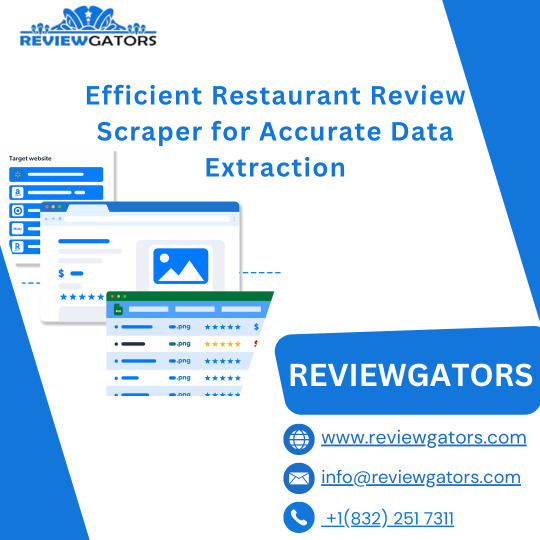
Efficient Restaurant Review Scraper for Accurate Data Extraction
Access valuable insights with a powerful restaurant review scraper that extracts authentic review data from major platforms. This tool is designed for businesses, analysts, and marketers seeking reliable restaurant review data scraping solutions. Efficiently extract user reviews, star ratings, timestamps, reviewer profiles, and sentiment indicators without complications.
The scraper helps multiple places, allowing you to monitor public opinion, track competitor performance,Data, and make informed decisions. Whether you are developing a food delivery platform, conducting market analysis, or operating a review-based service, this scraper ensures smooth and accurate data collection.
Designed for efficiency and accuracy, it reduces the time spent on manual research and automates large-scale data gathering. Stay informed with structured, filter-ready review data to support your analytics or business goals.
Gain access to trusted feedback, identify trending preferences, and improve your restaurant database effortlessly. The Restaurant Review Scraper ensures quality extraction with easy integration for developers and analysts. Get the right data to support smarter strategies.
0 notes
Text

Introduction
This case study highlights how our Glovo Data Scraping solutions empowered clients to monitor food delivery market trends strategically, refine service positioning, and execute agile, data-backed business strategies. Leveraging advanced scraping methodologies, we delivered actionable market intelligence that helped optimize decision-making, elevate competitiveness, and drive profitability.
Our solutions offered a clear strategic edge by enabling end-to-end visibility into the delivery ecosystem to Extract Food Delivery Data. This comprehensive insight allowed clients to fine-tune service models, sharpen market alignment, and achieve consistent revenue growth through accurate competitor benchmarking in the fast-moving food delivery sector.
The Client
A mid-sized restaurant chain operating across 75+ locations with a rapidly expanding digital footprint reached us with a critical operational challenge. Although the brand enjoyed strong recognition, it faced a noticeable drop in customer engagement driven by gaps in delivery service efficiency. To address this, Glovo Data Scraping was identified as a strategic solution, as service inconsistencies directly impacted their revenue goals and competitive position.
With a broad menu and widespread delivery zones, the restaurant struggled to manage delivery logistics, especially during peak hours when quick shifts in demand required fast action. Their manual approach failed to support Real-Time Glovo Data Scraping, leading to missed revenue opportunities and weakening customer loyalty.
Recognizing the need to refine their delivery strategy, the management team saw that without proper visibility into Glovo’s delivery ecosystem, they lacked the insights necessary for efficient operations and practical customer experience management.
Key Challenges Faced by the Client
In their pursuit of stronger delivery market intelligence and a sharper competitive edge, the client faced several operational and strategic hurdles:
Market Insight Shortage
Limited insights into Glovo's platform and competitors made scraping Glovo Delivery Information difficult, preventing effective market analysis necessary for informed business decisions.
Slow Response Adaptation
Reliance on manual weekly evaluations slowed the restaurant chain's ability to act quickly. Without Glovo Delivery Data Extraction, adapting to real-time market changes became a challenge.
Demand Forecasting Gap
Traditional methods failed to account for real-time delivery data. The restaurant chain needed Glovo Product Data Extraction to predict demand and adjust services based on emerging trends accurately.
Manual Process Overload
Labor-intensive processes hindered efficient service decisions. By applying methods to Scrape Glovo For Product Availability And Pricing, the restaurant chain sought automation to optimize service delivery.
Service Consistency Issue
Inconsistent service quality across zones presented a problem. They required Mobile App Scraping Solutions to streamline operations and ensure consistent service delivery across all customer touchpoints.
Key Solutions for Addressing Client Challenges
We implemented cutting-edge solutions to the client's challenges, combining delivery intelligence with advanced analytics.
Delivery Optimization Engine
We built a centralized platform that leverages Real-Time Glovo Delivery Time Data Extraction to collect live data from various restaurants and delivery zones, enabling efficient decision-making.
Competitor Monitoring System
Our system, designed to Extract Restaurant Menus And Prices From Glovo, quickly identifies service gaps when competitors adjust, giving restaurant chains the edge to adapt promptly.
Dynamic Market Signals
By integrating multiple delivery signals, such as peak hours and weather, with Glovo Scraping For Restaurant Delivery Services, we created flexible models that adjust to market fluctuations.
Automated Service Recommender
Using Real-Time Glovo Data Scraping, we implemented an automated engine that generates service suggestions based on customer feedback and competitive positioning, reducing the need for manual input.
Strategic Adjustment Mechanism
Competitor promotions directly influence our service strategies by using tools to Extract Food Delivery Data, optimizing delivery times and fees while ensuring premium offerings remain profitable.
Cloud-Based Monitoring Hub
A robust Mobile App Scraping Solution enables managers to access and update delivery data remotely, facilitating continuous optimization and transforming strategy management into a dynamic process.
Key Insights Gained from Glovo Data Scraping
Service Elasticity Analysis Revealed delivery time sensitivity across different menu items, offering immediate operational optimization opportunities.
Competitive Positioning Patterns Provided insights into neighborhood-specific delivery differences, supporting targeted service improvements.
Pricing Cycle Optimization Illuminated optimal fee adjustment timing for different meal categories, aiding in more strategic revenue management.
Data-Driven Service Decisions Enabled the implementation of adaptive delivery models based on competitive positioning patterns.
Benefits of Glovo Data Scraping From Retail Scrape
Strategic Boost
By utilizing solutions to Scrape Glovo Delivery Information, the client improved delivery strategies, positioning their services for maximum value, enhancing market responsiveness to competitive shifts.
Loyalty Growth
Using competitor service insights, the client predicted market trends and strengthened customer retention, employing to Extract Glovo Product Data to stay ahead of shifts in demand.
Efficient Operations
The client minimized manual efforts by employing advanced Real-Time Glovo Delivery Time Data Extraction, driving faster decisions and better service while ensuring precise positioning and operational success.
Competitive Edge
With advanced techniques to Scrape Glovo For Product Availability And Pricing, the client gained critical insights into market trends, allowing for service adjustments that boosted profitability in competitive delivery sectors.

Retail Scrape's Glovo Data Scraping solutions revolutionized our approach to delivery market positioning. By gaining comprehensive access to Extract Food Delivery Data insights, we rapidly adjusted our strategy, refined our service models, and achieved a remarkable 37% increase in customer retention.
- Operations Director, Leading Multi-Location Restaurant Chain
Conclusion
Maintaining optimal delivery service positioning is crucial in today's competitive food delivery market. Glovo Data Scraping empowers businesses to monitor competitor services, make informed decisions, and improve market competitiveness.
Our customized solutions offer smooth delivery intelligence and actionable insights, allowing businesses to refine their competitive positioning. With in-depth expertise in Glovo Delivery Data Extraction, we equip businesses with the tools to unlock valuable insights for strategic growth.
Our specialists help evaluate market positioning, refine delivery strategies, and boost profit margins through Real-Time Glovo Data Scraping. Contact Retail Scrape today to minimize service inconsistencies, enhance market positioning, and drive long-term revenue with our advanced food delivery intelligence solutions.
Read more >>https://www.retailscrape.com/glovo-food-delivery-data-scraping-for-market-insights.php
officially published by https://www.retailscrape.com/.
#Glovodatascraping#Glovodeliverydataextraction#ScrapeGlovodeliveryinformation#Real-timeGlovodatascraping#Glovoproductdataextraction#ExtractrestaurantmenusandpricesfromGlovo#Real-timeGlovodeliverytimedataextraction#ScrapeGlovoforproductavailabilityandpricing#Glovoscrapingforrestaurantdeliveryservices#ExtractFoodDeliveryData#MobileAppScrapingsolution
0 notes
Text
📦 The online #fooddeliverymarket is growing faster than ever — but how do businesses keep up with evolving #customerpreferences and fierce competition?

By using #WebScraping to collect structured, real-time data from platforms like #Foodpanda, companies can uncover powerful insights from restaurant listings, menu prices, delivery fees, and customer reviews.
🚴 With our #Foodpanda Food Data Scraping Services, you can:
Track competitor pricing strategies
Monitor delivery patterns and timing
Identify top-rated restaurants and dishes
Evaluate consumer feedback to refine offerings
Optimize your food delivery or analytics platform
From market research firms to food tech startups, having access to detailed Foodpanda data empowers smarter decisions, better forecasting, and enhanced customer engagement.
🌐 Don’t rely on guesswork — rely on data. Start extracting real-time restaurant intelligence now.
0 notes
Text
Monitor Competitor Pricing with Food Delivery Data Scraping

In the highly competitive food delivery industry, pricing can be the deciding factor between winning and losing a customer. With the rise of aggregators like DoorDash, Uber Eats, Zomato, Swiggy, and Grubhub, users can compare restaurant options, menus, and—most importantly—prices in just a few taps. To stay ahead, food delivery businesses must continually monitor how competitors are pricing similar items. And that’s where food delivery data scraping comes in.
Data scraping enables restaurants, cloud kitchens, and food delivery platforms to gather real-time competitor data, analyze market trends, and adjust strategies proactively. In this blog, we’ll explore how to use web scraping to monitor competitor pricing effectively, the benefits it offers, and how to do it legally and efficiently.
What Is Food Delivery Data Scraping?
Data scraping is the automated process of extracting information from websites. In the food delivery sector, this means using tools or scripts to collect data from food delivery platforms, restaurant listings, and menu pages.
What Can Be Scraped?
Menu items and categories
Product pricing
Delivery fees and taxes
Discounts and special offers
Restaurant ratings and reviews
Delivery times and availability
This data is invaluable for competitive benchmarking and dynamic pricing strategies.
Why Monitoring Competitor Pricing Matters
1. Stay Competitive in Real Time
Consumers often choose based on pricing. If your competitor offers a similar dish for less, you may lose the order. Monitoring competitor prices lets you react quickly to price changes and stay attractive to customers.
2. Optimize Your Menu Strategy
Scraped data helps identify:
Popular food items in your category
Price points that perform best
How competitors bundle or upsell meals
This allows for smarter decisions around menu engineering and profit margin optimization.
3. Understand Regional Pricing Trends
If you operate across multiple locations or cities, scraping competitor data gives insights into:
Area-specific pricing
Demand-based variation
Local promotions and discounts
This enables geo-targeted pricing strategies.
4. Identify Gaps in the Market
Maybe no competitor offers free delivery during weekdays or a combo meal under $10. Real-time data helps spot such gaps and create offers that attract value-driven users.
How Food Delivery Data Scraping Works
Step 1: Choose Your Target Platforms
Most scraping projects start with identifying where your competitors are listed. Common targets include:
Aggregators: Uber Eats, Zomato, DoorDash, Grubhub
Direct restaurant websites
POS platforms (where available)
Step 2: Define What You Want to Track
Set scraping goals. For pricing, track:
Base prices of dishes
Add-ons and customization costs
Time-sensitive deals
Delivery fees by location or vendor
Step 3: Use Web Scraping Tools or Custom Scripts
You can either:
Use scraping tools like Octoparse, ParseHub, Apify, or
Build custom scripts in Python using libraries like BeautifulSoup, Selenium, or Scrapy
These tools automate the extraction of relevant data and organize it in a structured format (CSV, Excel, or database).
Step 4: Automate Scheduling and Alerts
Set scraping intervals (daily, hourly, weekly) and create alerts for major pricing changes. This ensures your team is always equipped with the latest data.
Step 5: Analyze the Data
Feed the scraped data into BI tools like Power BI, Google Data Studio, or Tableau to identify patterns and inform strategic decisions.
Tools and Technologies for Effective Scraping
Popular Tools:
Scrapy: Python-based framework perfect for complex projects
BeautifulSoup: Great for parsing HTML and small-scale tasks
Selenium: Ideal for scraping dynamic pages with JavaScript
Octoparse: No-code solution with scheduling and cloud support
Apify: Advanced, scalable platform with ready-to-use APIs
Hosting and Automation:
Use cron jobs or task schedulers for automation
Store data on cloud databases like AWS RDS, MongoDB Atlas, or Google BigQuery
Legal Considerations: Is It Ethical to Scrape Food Delivery Platforms?
This is a critical aspect of scraping.
Understand Platform Terms
Many websites explicitly state in their Terms of Service that scraping is not allowed. Scraping such platforms can violate those terms, even if it’s not technically illegal.
Avoid Harming Website Performance
Always scrape responsibly:
Use rate limiting to avoid overloading servers
Respect robots.txt files
Avoid scraping login-protected or personal user data
Use Publicly Available Data
Stick to scraping data that’s:
Publicly accessible
Not behind paywalls or logins
Not personally identifiable or sensitive
If possible, work with third-party data providers who have pre-approved partnerships or APIs.
Real-World Use Cases of Price Monitoring via Scraping
A. Cloud Kitchens
A cloud kitchen operating in three cities uses scraping to monitor average pricing for biryani and wraps. Based on competitor pricing, they adjust their bundle offers and introduce combo meals—boosting order value by 22%.
B. Local Restaurants
A family-owned restaurant tracks rival pricing and delivery fees during weekends. By offering a free dessert on orders above $25 (when competitors don’t), they see a 15% increase in weekend orders.
C. Food Delivery Startups
A new delivery aggregator monitors established players’ pricing to craft a price-beating strategy, helping them enter the market with aggressive discounts and gain traction.
Key Metrics to Track Through Price Scraping
When setting up your monitoring dashboard, focus on:
Average price per cuisine category
Price differences across cities or neighborhoods
Top 10 lowest/highest priced items in your segment
Frequency of discounts and offers
Delivery fee trends by time and distance
Most used upsell combinations (e.g., sides, drinks)
Challenges in Food Delivery Data Scraping (And Solutions)
Challenge 1: Dynamic Content and JavaScript-Heavy Pages
Solution: Use headless browsers like Selenium or platforms like Puppeteer to scrape rendered content.
Challenge 2: IP Blocking or Captchas
Solution: Rotate IPs with proxies, use CAPTCHA-solving tools, or throttle request rates.
Challenge 3: Frequent Site Layout Changes
Solution: Use XPaths and CSS selectors dynamically, and monitor script performance regularly.
Challenge 4: Keeping Data Fresh
Solution: Schedule automated scraping and build change detection algorithms to prioritize meaningful updates.
Final Thoughts
In today’s digital-first food delivery market, being reactive is no longer enough. Real-time competitor pricing insights are essential to survive and thrive. Data scraping gives you the tools to make informed, timely decisions about your pricing, promotions, and product offerings.
Whether you're a single-location restaurant, an expanding cloud kitchen, or a new delivery platform, food delivery data scraping can help you gain a critical competitive edge. But it must be done ethically, securely, and with the right technologies.
0 notes
Text
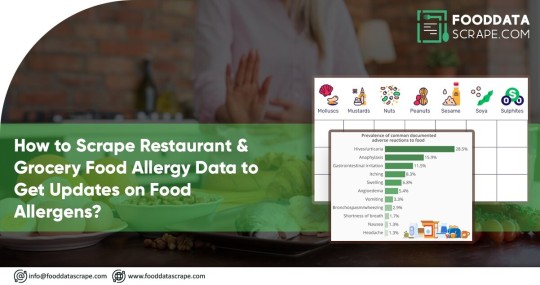
Read this blog to know why to scrape restaurant & grocery food allergy data to collect information regarding restaurants, food, menus, type of allergy encountered, etc.
Know more : https://medium.com/@fooddatascrape/how-to-scrape-restaurant-grocery-food-allergy-data-to-get-updates-on-food-allergens-112d364a7a85
#Scrape Restaurant & Grocery Food Allergy Data#Restaurant food data scraping#Scrape restaurant menus#Scrape food prices from different restaurants#Scraping data from food delivery platforms.#scraping food allergy data#scraping food and grocery review data
0 notes
Text
Case Study - Food Delivery App Scraping API for Real-Time Order & Restaurant Data

Introduction
Navigating the dynamic landscape of food delivery services presents significant challenges in today's rapidly evolving digital marketplace. This case study highlights how a leading food technology startup utilized Food Delivery App Scraping solutions to enhance market intelligence and streamline operational strategies.
The client faced difficulties accessing real-time insights on restaurant performance, menu pricing, and order dynamics across multiple digital platforms. To overcome these obstacles, they required a robust solution that could provide comprehensive visibility into the food delivery ecosystem.
The client revolutionized their market analysis approach by implementing advanced Scraping Food Delivery Price Data Using An API, unlocking data-driven competitive advantages in the fast-moving food technology sector.
Client Success Story

Our client, an innovative food technology startup with three years of experience in digital restaurant solutions, had built a strong reputation for delivering data-driven insights. However, the fragmented landscape of food delivery platforms posed a significant challenge in gathering comprehensive market intelligence.
Before implementing our solution, we were essentially operating in the dark," explains the company's Chief Strategy Officer. "Manually collecting data from various Food Delivery Apps Data Scraping API was time-consuming and inherently restrictive."
Adopting advanced capabilities to Scrape Data From Food Delivery Apps transformed their operational strategy. With access to precise, real-time insights into restaurant performance and pricing trends, they could make data-backed strategic decisions with unmatched accuracy.
Within six months of implementing the solution, the client achieved:
29% improvement in market intelligence precision
22% reduction in data collection operational costs
18% increase in strategic recommendation accuracy
15% growth in potential client engagement
The Core Challenge

The client encountered a series of interconnected challenges that were restricting their market understanding and strategic capabilities:
1. Data Collection Complexity
Digital food delivery platforms feature dynamic and ever-changing data landscapes, including fluctuating menus, pricing, and restaurant details. Traditional data collection methods proved insufficient in capturing this continuously evolving information.
2. Real-Time Market Intelligence Limitations
Existing solutions could not deliver instant insights into restaurant performance, pricing strategies, and order trends. Without access to comprehensive, real-time data, strategic decision-making was significantly hindered.
3. Scalability and Integration Obstacles
Businesses struggled to develop scalable mechanisms for Scraping Food Delivery Apps that could seamlessly integrate with their existing technological frameworks while ensuring data integrity and regulatory compliance.
The client required a sophisticated solution that could efficiently navigate these challenges and provide actionable insights without compromising operational workflows.
Smart Solution

After conducting a comprehensive analysis, we implemented a tailored approach that leverages advanced technologies to Extract Data From Food Delivery Apps effectively:
1. Comprehensive Data Collection Platform
Our state-of-the-art platform seamlessly extracts real-time data from multiple food delivery applications. It captures critical details such as restaurant menus, pricing structures, order volumes, and key performance metrics, ensuring a comprehensive market overview.
2. Advanced Analytics Engine
Equipped with a robust analytics engine, our solution converts raw data into meaningful strategic insights. It enables predictive modeling, in-depth trend analysis, and competitive intelligence reporting, empowering businesses with data-driven decision-making capabilities.
3. Adaptive Scraping Infrastructure
We developed a dynamic scraping infrastructure that effortlessly adapts to evolving platform architectures to maintain uninterrupted and reliable data collection. This ensures consistent, high-quality data extraction across various digital ecosystems.
The solution was designed with scalability in mind, enabling effortless expansion as the client's needs grew. We ensured smooth integration with existing systems, minimizing disruptions while maximizing the value derived from the collected data.
Execution Strategy

Implementing a comprehensive Food Delivery App Scraping solution required meticulous planning and execution. We followed a structured approach to ensure smooth deployment and optimal adoption:
1. Strategic Intelligence Mapping
In this phase, we conducted an in-depth analysis of food delivery platforms, mapping complex data ecosystems. We identified key data points to Scrape Food Delivery Apps, assessed technological challenges, and devised a comprehensive strategy to extract valuable insights across multiple digital platforms.
2. Advanced API Integration Development
During this phase, we developed custom tools to Extract Data From Food Delivery Apps, aligning with the client's market intelligence needs. We built robust API integration mechanisms, implemented advanced data normalization protocols, and designed intuitive dashboards that transformed raw data into actionable insights.
3. Compliance and Validation Protocols
In this critical phase, we rigorously tested Scraping Food Delivery Price Data Using An API solution to ensure accuracy, legal compliance, and real-world performance. Our validation process involved thorough algorithm testing, manual data verification, and continuous refinement of extraction methodologies.
4. Pilot Deployment and Training
We initiated a phased rollout of our Food Delivery Apps Data Scraping API, engaging key organizational stakeholders. Comprehensive training sessions were conducted, detailed SOPs were created, and monitoring protocols were implemented to ensure sustained data quality and system reliability.
5. Scalable Optimization and Expansion
The final phase focused on expanding scraping capabilities across multiple food delivery platforms while continuously refining data extraction parameters. We established ongoing optimization protocols to enhance efficiency, adaptability, and strategic value.
We ensured transparent communication with the client through regular updates and swift issue resolution. Our agile approach enabled continuous adaptation based on real-world performance and strategic feedback.
Impact & Results

The implementation of our Food Delivery App Scraping solution delivered transformative improvements across critical operational domains:
1. Market Intelligence Revolution
Our advanced scraping technologies enabled us to extract unprecedented market insights to Scrape Data From Food Delivery Apps with precision, providing a comprehensive view of restaurant performance, pricing, and competition.
2. Operational Efficiency Transformation
Automated data collection significantly reduced manual effort, enhancing operational efficiency. The solution eliminated repetitive tasks, allowing the team to focus on high-value strategic analysis and decision-making processes.
3. Predictive Analytics Enhancement
We can extract advanced predictive capabilities by capturing real-time data across multiple platforms. The solution transforms raw data into forward-looking insights, allowing for proactive strategy formulation and better competitive positioning.
4. Financial Performance Optimization
The comprehensive data intelligence directly contributed to improved financial performance. Insights derived from our scraping solution helped optimize pricing strategies, uncover new market opportunities, and support more informed business decisions.
5. Strategic Competitive Advantage
The Food Delivery App Scraping solution provided more than immediate benefits; it established a sustainable competitive edge. The client could adapt quickly to changes and make data-driven decisions by delivering real-time, comprehensive market intelligence.
Final Takeaways

The success of this project highlights the transformative potential of advanced Grocery Product Data Scraping technologies when strategically applied to retail operations. Several key takeaways emerged from this implementation:
Digital Transformation Imperative
The future of market intelligence requires embracing technological solutions that allow businesses to Scrape Data From Food Delivery Apps with exceptional accuracy and efficiency, driving more intelligent decisions.
Data Ecosystem Integration
To succeed, businesses must adopt comprehensive approaches integrating internal performance metrics with external market intelligence, forming a cohesive and actionable strategic framework.
Ethical Data Collection Principles
Adhering to ethical standards in Food Delivery Apps Data Scraping API practices is essential for maintaining compliance, building trust, and ensuring the long-term viability of business operations.
Predictive Analytics Evolution
Advanced platforms are revolutionizing how businesses use raw data, transforming it into actionable insights that allow them to forecast market trends and make proactive decisions.
Competitive Intelligence Dynamics
Organizations that excel in Extracting Data From Food Delivery Apps will unlock significant competitive advantages, using the data to refine their market positioning and strategies.
Client Testimonial
"Our approach to market analysis has undergone a complete transformation. The Food Delivery App Scraping solution has provided unprecedented insights, allowing us to make more informed decisions and strategically position ourselves in an increasingly competitive market."
- Chief Technology Officer, Food Technology Startup
Conclusion
Are you finding it challenging to track restaurant listings, monitor competitor pricing, or optimize order accuracy? Our Food Delivery App Scraping solution is designed to provide your business with real-time insights that enable more intelligent decision-making. Whether your goal is to extract valuable data from food delivery apps or automate pricing adjustments, our team has the expertise to streamline and elevate your operations.
Contact Web Data Crawler today for a complimentary consultation and learn how our Food Delivery Apps Data Scraping API can offer your business a competitive advantage. Let us assist you in harnessing the potential of real-time data to fuel success in the dynamic and rapidly changing food delivery industry.
Originally published at https://www.webdatacrawler.com.
#FoodDeliveryAppScraping#ExtractDataFromFoodDeliveryApps#FoodDeliveryAppsDataScrapingAPI#ScrapingFoodDeliveryPriceDataUsingAPI#RestaurantDataExtraction#RealTimeOrderDataScraping#RestaurantMarketIntelligence#WebScrapingServices#FoodTechDataScraping#FoodDeliveryDataAnalytics#CompetitorPriceTracking#MenuPricingDataScraping#OnlineFoodOrderingDataExtraction#EcommerceFoodPricingIntelligence#CustomerSentimentAnalysisForFoodApps
0 notes
Text
Introduction - The Rise of On-Demand Delivery Platforms like Glovo
The global landscape of e-commerce and food delivery has witnessed an unprecedented transformation with the rise of on-demand delivery platforms. These platforms, including Glovo, have capitalized on the increasing demand for fast, convenient, and contactless delivery solutions. In 2020 alone, the global on-demand delivery industry was valued at over $100 billion and is projected to grow at a compound annual growth rate (CAGR) of 23% until 2027. The Glovo platform, which began in Spain, has expanded to more than 25 countries and 250+ cities worldwide, offering services ranging from restaurant deliveries to grocery and pharmaceutical goods.
The widespread use of smartphones and changing consumer habits have driven the growth of delivery services, making it a vital part of the modern retail ecosystem. Consumers now expect fast, accurate, and accessible delivery from local businesses, and platforms like Glovo have become key players in this demand. As businesses strive to stay competitive, Glovo Data Scraping plays an essential role in acquiring real-time insights and market intelligence.
On-demand delivery services are no longer a luxury but a necessity for businesses, and companies that harness reliable data will lead the charge. Let’s examine the growing need for accurate delivery data as we look deeper into the challenges faced by businesses relying on real-time information.
Real-Time Delivery Data Changes Frequently

While platforms like Glovo are revolutionizing the delivery landscape, one of the significant challenges businesses face is the inconsistency and volatility of real-time data. Glovo, like other on-demand services, operates in a dynamic environment where store availability, pricing, and inventory fluctuate frequently. A store’s listing can change based on delivery zones, operating hours, or ongoing promotions, making it difficult for businesses to rely on static data for decision-making.
For example, store availability can vary by time of day—some stores may not be operational during off-hours, or a delivery fee could change based on the customer’s location. The variability in Glovo Delivery Data Scraping extends to pricing, with each delivery zone potentially having different costs for the same product, depending on the distance or demand.
This constant flux in data can lead to several challenges, such as inconsistent pricing strategies, missed revenue opportunities, and poor customer experience. Moreover, with shared URLs for chains like McDonald’s or KFC, Glovo Scraper API tools must be precise in extracting data across multiple store locations to ensure data accuracy.
The problem becomes even more significant when businesses need to rely on data for forecasting, marketing, and real-time decision-making. Glovo API Scraping and other advanced scraping methods offer a potential solution, helping to fill the gaps in data accuracy.
Stay ahead of the competition by leveraging Glovo Data Scraping for accurate, real-time delivery data insights. Contact us today!
Contact Us Today!
The Need for Glovo Data Scraping to Maintain Reliable Business Intelligence

As businesses struggle to keep up with the ever-changing dynamics of Glovo’s delivery data, the importance of reliable data extraction becomes more evident. Glovo Data Scraping offers a powerful solution for companies seeking accurate, real-time data that can support decision-making and business intelligence. Unlike traditional methods of manually tracking updates, automated scraping using Glovo Scraper tools can continuously fetch the latest store availability, menu items, pricing, and delivery conditions.
Utilizing Glovo API Scraping ensures that businesses have access to the most up-to-date and accurate data on a regular basis, mitigating the challenges posed by fluctuating delivery conditions. Whether it’s monitoring Glovo Restaurant Data Scraping for competitive pricing or gathering Glovo Menu Data Extraction for inventory management, data scraping empowers businesses to optimize operations and gain an edge over competitors.
Moreover, Glovo Delivery Data Scraping ensures that companies can monitor changes in delivery fees, product availability, and pricing models, allowing them to adapt their strategies to real-time conditions. For companies in sectors like Q-commerce, which depend heavily on timely and accurate data, integrating Scrape Glovo Data into their data pipelines can dramatically enhance operational efficiency and business forecasting.
Through intelligent Glovo Scraper API solutions, companies can bridge the data gap and create more informed strategies to capture market opportunities.
The Problems with Glovo’s Real-Time Data
Glovo, a major player in the on-demand delivery ecosystem, faces challenges in providing accurate and consistent data to its users. These issues can lead to discrepancies in business intelligence, making it difficult for organizations to rely on the platform for accurate decision-making. Several critical problems hinder the effective use of Glovo Data Scraping and Glovo API Scraping. Let’s explore these problems in detail.
1. Glovo Only Shows Stores That Are Online at the Moment
One of the primary issues with Glovo is that it only displays stores that are currently online, which means businesses may miss potential opportunities. Store availability can fluctuate rapidly throughout the day, and a business may only see a partial picture of the stores operating at any given time. This makes it difficult to make decisions based on a consistent dataset, especially for those relying on real-time data.
To address this issue, companies must use Web Scraping Glovo Delivery Data to scrape data multiple times a day. By performing automated scraping at different intervals, businesses can ensure they gather complete data and avoid gaps caused by the transient nature of store availability.
2. Listings Vary by Time of Day and Delivery Radius
Another challenge is the variation in store listings by time of day and delivery radius. Due to Glovo’s dynamic delivery system, the availability of stores changes based on the user’s delivery location and the time of day. A restaurant that is available in the morning may not be available in the evening, or it may charge different delivery fees depending on the delivery zone. This introduces significant volatility in data that businesses must account for.
The solution is to Scrape Glovo Data using location-based API scraping techniques. With the right strategies, Glovo Scraper API tools can be programmed to fetch this data by specific delivery zones, ensuring a more accurate representation of store listings.
3. Shared URLs Across Multiple Branches Complicate Precise Location Tracking
For larger chains like McDonald's or KFC, Glovo often uses a single URL to represent multiple store branches within the same city. This means that all data tied to a single restaurant chain will be lumped together, even though there may be differences in location, inventory, and pricing. Such discrepancies complicate accurate data collection and make it harder to pinpoint specific store information.
The answer lies in Glovo Restaurant Data Scraping. By utilizing advanced scraping tools like Glovo Scraper and incorporating specific store locations within the scraping process, businesses can separate out data for each branch and ensure a more accurate dataset.
4. Gaps in Sitemap Coverage and Dynamic Delivery-Based Pricing Add Complexity
Glovo's sitemap often lacks comprehensive coverage of all stores, which further complicates data extraction. For example, some cities may have incomplete data on restaurant availability or listings may be outdated. Additionally, dynamic pricing based on delivery distance, demand, and time of day adds another layer of complexity. Pricing variations can be difficult to track accurately, especially for businesses that require up-to-date data for competitive pricing strategies.
Glovo Pricing Data Scraping can help resolve this issue by extracting dynamic pricing from multiple locations, ensuring businesses always have the most current pricing information. With Glovo Delivery Data Scraping, companies can access detailed pricing data in real-time and adjust their strategies based on accurate, up-to-date information.
By addressing these challenges through smart Glovo Data Scraping and leveraging technologies like Glovo Scraper API and Glovo Delivery Data Scraping, businesses can collect more accurate and reliable data, enabling them to adapt more effectively to the fluctuations in real-time delivery information. These tools help streamline data collection, making it easier for businesses to stay competitive in a fast-moving market. Learn More
#LocationBasedAPIScraping#GlovoMenuDataExtraction#GlovoScraperAPITools#GlovoDeliveryDataScraping#GlovoDataScraping
0 notes
Text
How to Track Restaurant Promotions on Instacart and Postmates Using Web Scraping
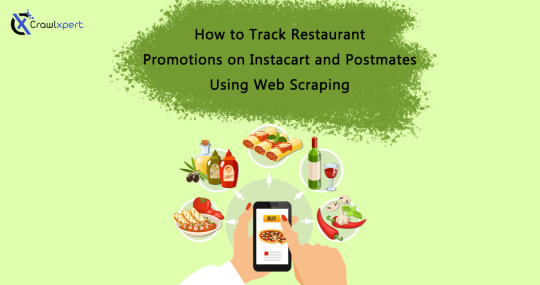
Introduction
With the rapid growth of food delivery services, companies such as Instacart and Postmates are constantly advertising for their restaurants to entice customers. Such promotions can range from discounts and free delivery to combinations and limited-time offers. For restaurants and food businesses, tracking these promotions gives them a competitive edge to better adjust their pricing strategies, identify trends, and stay ahead of their competitors.
One of the topmost ways to track promotions is using web scraping, which is an automated way of extracting relevant data from the internet. This article examines how to track restaurant promotions from Instacart and Postmates using the techniques, tools, and best practices in web scraping.
Why Track Restaurant Promotions?
1. Contest Research
Identify promotional strategies of competitors in the market.
Compare their discounting rates between restaurants.
Create pricing strategies for competitiveness.
2. Consumer Behavior Intuition
Understand what kinds of promotions are the most patronized by customers.
Deducing patterns that emerge determine what day, time, or season discounts apply.
Marketing campaigns are also optimized based on popular promotions.
3. Distribution Profit Maximization
Determine the optimum timing for promotion in restaurants.
Analyzing competitors' discounts and adjusting is critical to reducing costs.
Maximize the Return on investments, and ROI of promotional campaigns.
Web Scraping Techniques for Tracking Promotions
Key Data Fields to Extract
To effectively monitor promotions, businesses should extract the following data:
Restaurant Name – Identify which restaurants are offering promotions.
Promotion Type – Discounts, BOGO (Buy One Get One), free delivery, etc.
Discount Percentage – Measure how much customers save.
Promo Start & End Date – Track duration and frequency of offers.
Menu Items Included – Understand which food items are being promoted.
Delivery Charges - Compare free vs. paid delivery promotions.
Methods of Extracting Promotional Data
1. Web Scraping with Python
Using Python-based libraries such as BeautifulSoup, Scrapy, and Selenium, businesses can extract structured data from Instacart and Postmates.
2. API-Based Data Extraction
Some platforms provide official APIs that allow restaurants to retrieve promotional data. If available, APIs can be an efficient and legal way to access data without scraping.
3. Cloud-Based Web Scraping Tools
Services like CrawlXpert, ParseHub, and Octoparse offer automated scraping solutions, making data extraction easier without coding.
Overcoming Anti-Scraping Measures
1. Avoiding IP Blocks
Use proxy rotation to distribute requests across multiple IP addresses.
Implement randomized request intervals to mimic human behavior.
2. Bypassing CAPTCHA Challenges
Use headless browsers like Puppeteer or Playwright.
Leverage CAPTCHA-solving services like 2Captcha.
3. Handling Dynamic Content
Use Selenium or Puppeteer to interact with JavaScript-rendered content.
Scrape API responses directly when possible.
Analyzing and Utilizing Promotion Data
1. Promotional Dashboard Development
Create a real-time dashboard to track ongoing promotions.
Use data visualization tools like Power BI or Tableau to monitor trends.
2. Predictive Analysis for Promotions
Use historical data to forecast future discounts.
Identify peak discount periods and seasonal promotions.
3. Custom Alerts for Promotions
Set up automated email or SMS alerts when competitors launch new promotions.
Implement AI-based recommendations to adjust restaurant pricing.
Ethical and Legal Considerations
Comply with robots.txt guidelines when scraping data.
Avoid excessive server requests to prevent website disruptions.
Ensure extracted data is used for legitimate business insights only.
Conclusion
Web scraping allows tracking restaurant promotions at Instacart and Postmates so that businesses can best optimize their pricing strategies to maximize profits and stay ahead of the game. With the help of automation, proxies, headless browsing, and AI analytics, businesses can beautifully keep track of and respond to the latest promotional trends.
CrawlXpert is a strong provider of automated web scraping services that help restaurants follow promotions and analyze competitors' strategies.
0 notes
Text
Restaurant Trend Analysis with Food Delivery Data | ArcTechnolabs
Introduction
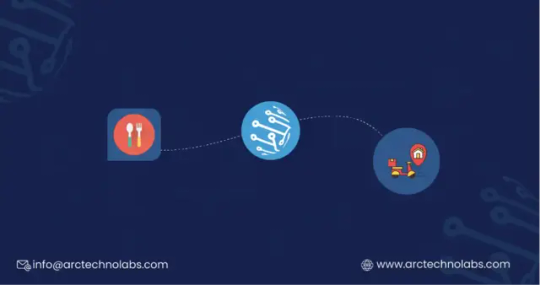
Food delivery isn’t just about convenience anymore—it’s a data goldmine. In fast-paced markets like the UAE and Singapore, food delivery platforms serve as real-time mirrors of restaurant performance, cuisine trends, pricing models, and consumer preferences.
ArcTechnolabs brings powerful visibility into this ecosystem with ready-made datasets��scraped from top platforms such as Talabat, Deliveroo, Zomato, Careem NOW (UAE), GrabFood, and Foodpanda (Singapore).
If you're building a restaurant analytics platform, benchmarking food delivery pricing, or launching a virtual kitchen, our datasets deliver instant, structured, and geo-tagged intelligence.
Why UAE and Singapore?
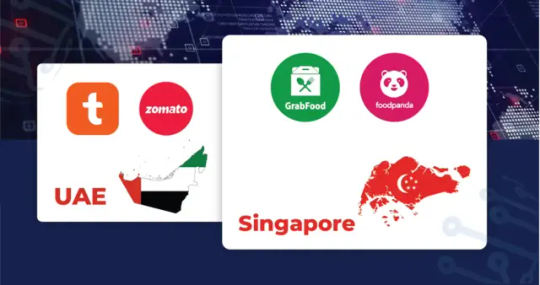
UAE: Burgeoning QSR chains, cloud kitchen boom, and highly competitive platforms like Talabat and Zomato.
Singapore: Tech-savvy urban population, high delivery frequency, and GrabFood/Foodpanda dominance.
Both countries represent a gold standard for online ordering behavior and digital F&B operations.
What ArcTechnolabs Provides
ArcTechnolabs delivers structured, high-quality datasets extracted from leading food delivery platforms. These datasets include the following key attributes:
-Restaurant Name: The exact listing name as it appears on food delivery platforms. -Cuisine Type: Cuisine categories such as Chinese, Indian, Fast Food, Arabic, etc. -Item Names: Menu items with details including portion size. -Item Prices: Both original and discounted prices. -Delivery Fee: Platform-specific delivery charges. -Ratings: Average customer rating along with total review count. -Delivery Time Estimate: Estimated delivery time as shown on the platform (e.g., 30–40 minutes). -Offer/Discount: Promotional offers such as percentage discounts, coupons, and bundle deals. -Scraped From: Platforms including Zomato, GrabFood, Deliveroo, Talabat, Foodpanda, and others.
Sample Dataset – UAE (Talabat + Zomato)
Restaurant: Al Baik Express
Cuisine: Arabic
Item: Chicken Broast
Price: AED 25.00
Rating: 4.5
Estimated Delivery Time: 30–40 minutes
Restaurant: Burgerizzr
Cuisine: Fast Food
Item: Double Burger
Price: AED 32.00
Rating: 4.3
Estimated Delivery Time: 20–30 minutes
Sample Dataset – Singapore (GrabFood + Foodpanda)
Restaurant: Boon Tong Kee
Cuisine: Chinese
Item: Steamed Chicken
Price: SGD 12.80
Rating: 4.6
Estimated Delivery Time: 25–35 minutes
Restaurant: Crave Nasi Lemak
Cuisine: Malay
Item: Chicken Wing Set
Price: SGD 9.90
Rating: 4.4
Estimated Delivery Time: 20–25 minutes
Use Cases for Food Delivery Data
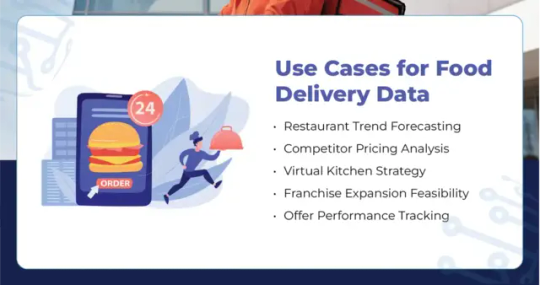
1. Restaurant Trend Forecasting
Track top-performing cuisines, trending dishes, and delivery frequency by city.
2. Competitor Pricing Analysis
Compare QSR pricing across cities/platforms to optimize your own.
3. Virtual Kitchen Strategy
Use delivery times, cuisine gaps, and demand signals to plan kitchen placement.
4. Franchise Expansion Feasibility
Measure brand performance before launching in new areas.
5. Offer Performance Tracking
Analyze how discount combos affect order ratings and visibility.
How ArcTechnolabs Builds These Datasets
Platform Selection: We target top food delivery apps across UAE and Singapore.
Geo-Based Filtering: Listings are segmented by city, area, and delivery radius.
Smart Scraping Engines: Handle pagination, time delays, JavaScript rendering.
Normalization: Menu names, price formatting, cuisine tagging, and duplication removal.
Delivery ETA Tracking: Extract exact delivery time estimates across dayparts.
Data Refresh Options
ArcTechnolabs offers flexible data refresh options to match your operational or analytical needs:
Hourly Updates
Channel: API or JSON feed
Format: Real-time data access
Daily Updates
Channel: Email delivery or direct download
Format: CSV or Excel
Weekly Trend Reports
Channel: Shared via email or Google Drive
Format: Summary reports with key insights
Target Cities ArcTechnolabs focuses on high-demand urban areas for precise, city-level analysis.
UAE:
Dubai
Abu Dhabi
Sharjah
Ajman
Al Ain
Singapore:
Central
Tampines
Jurong
Bukit Batok
Ang Mo Kio
Customization Options You can tailor your dataset to meet specific business goals or research parameters. Customization options include:
Cuisine Filter: Focus on select cuisines such as Indian, Arabic, or Chinese.
Platform Filter: Limit data to a specific platform like Talabat or GrabFood.
Time of Day: Filter listings by lunch, dinner, or early morning availability.
Restaurant Type: Choose data only from cloud kitchens or dine-in restaurants.
Discount Status: Include only restaurants currently offering deals or promotions.
Benefits of ArcTechnolabs’ Pre-Scraped Datasets

Fast deployment
City-wise trend segmentation
Competitor menu benchmarks
Multi-platform support
Clean & normalized structure
Get Started in 3 Steps
Request your sample dataset
Choose your region, platform & cuisine focus
Start receiving insights via API or scheduled exports
Visit ArcTechnolabs.com to request a demo or consultation.
Conclusion
The future of food delivery is data-driven. Whether you're analyzing dish popularity, price competitiveness, or delivery performance— ArcTechnolabs equips you with plug-and-play food delivery datasets that transform static restaurant listings into live market intelligence.
Get smart. Get fast. Get food trend insights—powered by ArcTechnolabs.
Source >> https://www.arctechnolabs.com/restaurant-trends-with-food-delivery-dataset.php
#ReadyMadeDatasets#RealTimeRestaurantAnalyticsDataset#ZomatoDatasetForRestaurantAnalysis#RestaurantTrendAnalysisDatasets#RestaurantPerformanceDataScraping#FoodDeliveryPricingDatasets#WebScrapingServices
0 notes
Text
DoorDash API - DoorDash Scraper - DoorDash Reviews API
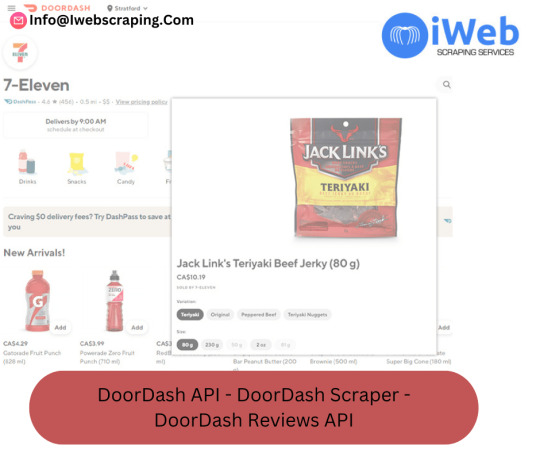
The digital age has transformed how we access services, including food delivery. DoorDash, a leading food delivery service, has not only revolutionized the way we order food but also offers a suite of APIs and tools for developers and businesses to harness its vast data. In this blog, we will explore the DoorDash API, DoorDash Scraper, and DoorDash Reviews API, highlighting their functionalities, use cases, and potential benefits.
DoorDash API
Overview
The DoorDash API provides a robust platform for developers to integrate DoorDash's delivery services into their applications. Whether you are running a restaurant, a logistics company, or a startup looking to offer delivery solutions, the DoorDash API can be a game-changer.
Key Features
Order Management: The API allows seamless integration of order placement, tracking, and management. Restaurants and businesses can manage their DoorDash orders directly from their existing systems.
Delivery Tracking: Real-time tracking of deliveries helps businesses keep their customers informed about the status of their orders.
Menu Management: Businesses can manage their menus, including item descriptions, prices, and availability, directly through the API.
Use Cases
Restaurants: Integrate DoorDash delivery into their own apps or websites, providing a seamless customer experience.
E-commerce Platforms: Offer on-demand delivery for non-food items, leveraging DoorDash's logistics network.
Logistics Companies: Enhance their service offerings with real-time delivery tracking and management.
DoorDash Scraper
Overview
A DoorDash scraper is a tool designed to extract data from the DoorDash platform. While scraping can be a contentious issue, with ethical and legal considerations, it remains a powerful method for obtaining data for analysis, market research, and competitive intelligence.
Key Features
Data Extraction: Scrapers can collect data on restaurant listings, menus, prices, customer reviews, and delivery times.
Automation: Automated scrapers can continuously gather data, ensuring that the information is up-to-date.
Customization: Users can tailor scrapers to collect specific data points based on their needs.
Use Cases
Market Research: Businesses can analyze competitor offerings, pricing strategies, and customer reviews to inform their own strategies.
Data Analysis: Researchers and analysts can use the data to identify trends, customer preferences, and market opportunities.
Inventory Management: Restaurants can track menu items' popularity and adjust their inventory and offerings accordingly.
Ethical Considerations
While scraping can provide valuable data, it is crucial to adhere to ethical guidelines:
Respect Terms of Service: Always check DoorDash's terms of service to ensure compliance.
Data Privacy: Avoid scraping personal data to respect user privacy and comply with data protection laws.
Rate Limiting: Implement rate limiting to avoid overwhelming the DoorDash servers and potentially causing service disruptions.
DoorDash Reviews API
Overview
Customer reviews are a goldmine of information, offering insights into customer satisfaction, preferences, and areas for improvement. The DoorDash Reviews API allows businesses to access and analyze customer reviews directly.
Key Features
Review Retrieval: Access reviews based on various criteria such as date, rating, and keywords.
Sentiment Analysis: Analyze the sentiment of reviews to gauge customer satisfaction and identify common pain points.
Actionable Insights: Use the data to make informed decisions on menu changes, service improvements, and marketing strategies.
Use Cases
Quality Improvement: Identify recurring issues in customer feedback and address them to improve service quality.
Customer Engagement: Respond to reviews directly through the API, showing customers that their feedback is valued.
Competitive Analysis: Compare reviews of your business with those of competitors to identify strengths and weaknesses.
0 notes
Text
Realigning Food Delivery Market Moves with Precision Through Glovo Data Scraping

Introduction
This case study highlights how our Glovo Data Scraping solutions empowered clients to monitor food delivery market trends strategically, refine service positioning, and execute agile, data-backed business strategies. Leveraging advanced scraping methodologies, we delivered actionable market intelligence that helped optimize decision-making, elevate competitiveness, and drive profitability.
Our solutions offered a clear strategic edge by enabling end-to-end visibility into the delivery ecosystem to Extract Food Delivery Data. This comprehensive insight allowed clients to fine-tune service models, sharpen market alignment, and achieve consistent revenue growth through accurate competitor benchmarking in the fast-moving food delivery sector.
The Client
A mid-sized restaurant chain operating across 75+ locations with a rapidly expanding digital footprint reached us with a critical operational challenge. Although the brand enjoyed strong recognition, it faced a noticeable drop in customer engagement driven by gaps in delivery service efficiency. To address this, Glovo Data Scraping was identified as a strategic solution, as service inconsistencies directly impacted their revenue goals and competitive position.
With a broad menu and widespread delivery zones, the restaurant struggled to manage delivery logistics, especially during peak hours when quick shifts in demand required fast action. Their manual approach failed to support Real-Time Glovo Data Scraping, leading to missed revenue opportunities and weakening customer loyalty.
Recognizing the need to refine their delivery strategy, the management team saw that without proper visibility into Glovo’s delivery ecosystem, they lacked the insights necessary for efficient operations and practical customer experience management.
Key Challenges Faced by the Client
In their pursuit of stronger delivery market intelligence and a sharper competitive edge, the client faced several operational and strategic hurdles:
Market Insight Shortage
Limited insights into Glovo's platform and competitors made scraping Glovo Delivery Information difficult, preventing effective market analysis necessary for informed business decisions.
Slow Response Adaptation
Reliance on manual weekly evaluations slowed the restaurant chain's ability to act quickly. Without Glovo Delivery Data Extraction, adapting to real-time market changes became a challenge.
Demand Forecasting Gap
Traditional methods failed to account for real-time delivery data. The restaurant chain needed Glovo Product Data Extraction to predict demand and adjust services based on emerging trends accurately.
Manual Process Overload
Labor-intensive processes hindered efficient service decisions. By applying methods to Scrape Glovo For Product Availability And Pricing, the restaurant chain sought automation to optimize service delivery.
Service Consistency Issue
Inconsistent service quality across zones presented a problem. They required Mobile App Scraping Solutions to streamline operations and ensure consistent service delivery across all customer touchpoints.
Key Solutions for Addressing Client Challenges
We implemented cutting-edge solutions to the client's challenges, combining delivery intelligence with advanced analytics.
Delivery Optimization Engine
We built a centralized platform that leverages Real-Time Glovo Delivery Time Data Extraction to collect live data from various restaurants and delivery zones, enabling efficient decision-making.
Competitor Monitoring System
Our system, designed to Extract Restaurant Menus And Prices From Glovo, quickly identifies service gaps when competitors adjust, giving restaurant chains the edge to adapt promptly.
Dynamic Market Signals
By integrating multiple delivery signals, such as peak hours and weather, with Glovo Scraping For Restaurant Delivery Services, we created flexible models that adjust to market fluctuations.
Automated Service Recommender
Using Real-Time Glovo Data Scraping, we implemented an automated engine that generates service suggestions based on customer feedback and competitive positioning, reducing the need for manual input.
Strategic Adjustment Mechanism
Competitor promotions directly influence our service strategies by using tools to Extract Food Delivery Data, optimizing delivery times and fees while ensuring premium offerings remain profitable.
Cloud-Based Monitoring Hub
A robust Mobile App Scraping Solution enables managers to access and update delivery data remotely, facilitating continuous optimization and transforming strategy management into a dynamic process.
Key Insights Gained from Glovo Data Scraping
Service Elasticity Analysis Revealed delivery time sensitivity across different menu items, offering immediate operational optimization opportunities.
Competitive Positioning Patterns Provided insights into neighborhood-specific delivery differences, supporting targeted service improvements.
Pricing Cycle Optimization Illuminated optimal fee adjustment timing for different meal categories, aiding in more strategic revenue management.
Data-Driven Service Decisions Enabled the implementation of adaptive delivery models based on competitive positioning patterns.
Benefits of Glovo Data Scraping From Retail Scrape
Strategic Boost
By utilizing solutions to Scrape Glovo Delivery Information, the client improved delivery strategies, positioning their services for maximum value, enhancing market responsiveness to competitive shifts.
Loyalty Growth
Using competitor service insights, the client predicted market trends and strengthened customer retention, employing to Extract Glovo Product Data to stay ahead of shifts in demand.
Efficient Operations
The client minimized manual efforts by employing advanced Real-Time Glovo Delivery Time Data Extraction, driving faster decisions and better service while ensuring precise positioning and operational success.
Competitive Edge
With advanced techniques to Scrape Glovo For Product Availability And Pricing, the client gained critical insights into market trends, allowing for service adjustments that boosted profitability in competitive delivery sectors.

Retail Scrape's Glovo Data Scraping solutions revolutionized our approach to delivery market positioning. By gaining comprehensive access to Extract Food Delivery Data insights, we rapidly adjusted our strategy, refined our service models, and achieved a remarkable 37% increase in customer retention.
- Operations Director, Leading Multi-Location Restaurant Chain
Conclusion
Maintaining optimal delivery service positioning is crucial in today's competitive food delivery market. Glovo Data Scraping empowers businesses to monitor competitor services, make informed decisions, and improve market competitiveness.
Our customized solutions offer smooth delivery intelligence and actionable insights, allowing businesses to refine their competitive positioning. With in-depth expertise in Glovo Delivery Data Extraction, we equip businesses with the tools to unlock valuable insights for strategic growth.
Our specialists help evaluate market positioning, refine delivery strategies, and boost profit margins through Real-Time Glovo Data Scraping. Contact Retail Scrape today to minimize service inconsistencies, enhance market positioning, and drive long-term revenue with our advanced food delivery intelligence solutions.
Read more >>https://www.retailscrape.com/glovo-food-delivery-data-scraping-for-market-insights.php
officially published by https://www.retailscrape.com/.
#Glovo data scraping#Glovo delivery data extraction#Scrape Glovo delivery information#Real-time Glovo data scraping#Glovo product data extraction#Extract restaurant menus and prices from Glovo#Real-time Glovo delivery time data extraction#Scrape Glovo for product availability and pricing#Glovo scraping for restaurant delivery services#Extract Food Delivery Data#Mobile App Scraping solution
0 notes